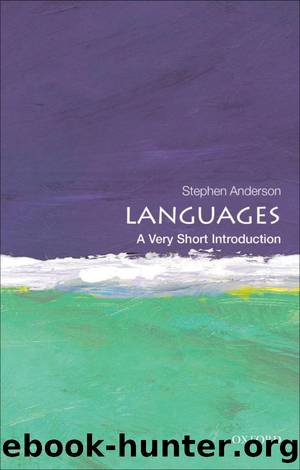Languages: A Very Short Introduction by Stephen Anderson

Author:Stephen Anderson [Anderson, Stephen]
Language: eng
Format: epub
ISBN: 9780199590599
Publisher: Oxford University Press
Published: 2012-12-15T06:00:00+00:00
Differentiating languages from one another
One common-sense notion of when we are dealing with different languages, as opposed to different forms of the same language, is the criterion of mutual intelligibility: if the speakers of A can understand the speakers of B without difficulty, A and B must be the same language. This is the basic principle that Ethnologue uses to distinguish languages, although they are not completely consistent in applying it. For instance, the language listing for Switzerland includes âSwiss Germanâ, distinct from standard German and treated as one language. Nonetheless, they note that â[e]ach canton has [a] separate variety, many mutually unintelligibleâ. In fact, there are many more varieties of Swiss German than there are cantons, and some of these are indeed mutually unintelligible to a significant extent, and so ought properly to have been treated as separate languages if this criterion were taken literally. Apparently, one has to stop the fragmentation somewhere, but the result is somewhat problematic.
In fact, the notion of separating languages on the basis of mutual intelligibility is very similar to the âbiological speciesâ concept mentioned in Chapter 1, on which organisms are assigned to different species to the extent they cannot reproduce with one another. While widely accepted, that notion also has its problems. Some of these are unique to the biological context: for instance, horses and donkeys are assigned to separate species, but in fact they can reproduce with one another, yielding either mules (if the father is a donkey and the mother a horse) or hinnies (in the reverse case). Mules and hinnies, on the other hand, are generally infertile and cannot reproduce with horses, donkeys, or each other. To what species do these animals belong? And is it relevant that a small number of female mules actually have produced offspring with male horses or donkeys? Fortunately, we do not have to resolve comparable conundrums in the case of languages.
Just as the biological species concept does not yield a completely clean division of organisms into species, so the notion of mutual intelligibility also fails in practice to cut the world up into clearly distinct language units. The problems are not precisely parallel, of course. Mutual intelligibility among languages is a somewhat gradient phenomenon (Catalan speakers and Spanish speakers without a background in the othersâ language cannot completely understand one another, but either can understand more of the other language than they could understand from a monolingual Japanese tourist), while reproductive isolation is much more nearly categorical. But there are some interesting similarities.
In some instances, speakers of A can understand B, but not vice versa, or at least speakers of B will insist that they cannot understand A. In some instances, these asymmetries are probably quite real. Among the Scandinavian languages, native speakers of Danish generally report being able to understand a great deal of what is said in (Riksmål) Norwegian, which is not surprising, given that this language has its origin in the Danish spoken in Norway as a standard under Danish rule of the country from the 16th through the early 19th century.
Download
This site does not store any files on its server. We only index and link to content provided by other sites. Please contact the content providers to delete copyright contents if any and email us, we'll remove relevant links or contents immediately.
| Africa | Americas |
| Arctic & Antarctica | Asia |
| Australia & Oceania | Europe |
| Middle East | Russia |
| United States | World |
| Ancient Civilizations | Military |
| Historical Study & Educational Resources |
Never by Ken Follett(3489)
Machine Learning at Scale with H2O by Gregory Keys | David Whiting(3436)
Fairy Tale by Stephen King(2855)
The Man Who Died Twice by Richard Osman(2777)
Will by Will Smith(2547)
Oathbringer (The Stormlight Archive, Book 3) by Brandon Sanderson(2448)
Rationality by Steven Pinker(2122)
The Dark Hours by Michael Connelly(1995)
The Dawn of Everything: A New History of Humanity by David Graeber & David Wengrow(1988)
Can't Hurt Me: Master Your Mind and Defy the Odds - Clean Edition by David Goggins(1960)
Friends, Lovers, and the Big Terrible Thing by Matthew Perry(1954)
Principles for Dealing With the Changing World Order: Why Nations Succeed and Fail by Ray Dalio(1851)
HBR's 10 Must Reads 2022 by Harvard Business Review(1676)
A Short History of War by Jeremy Black(1646)
Go Tell the Bees That I Am Gone by Diana Gabaldon(1570)
515945210 by Unknown(1499)
443319537 by Unknown(1372)
A Game of Thrones (The Illustrated Edition) by George R. R. Martin(1323)
Kingdom of Ash by Maas Sarah J(1317)
